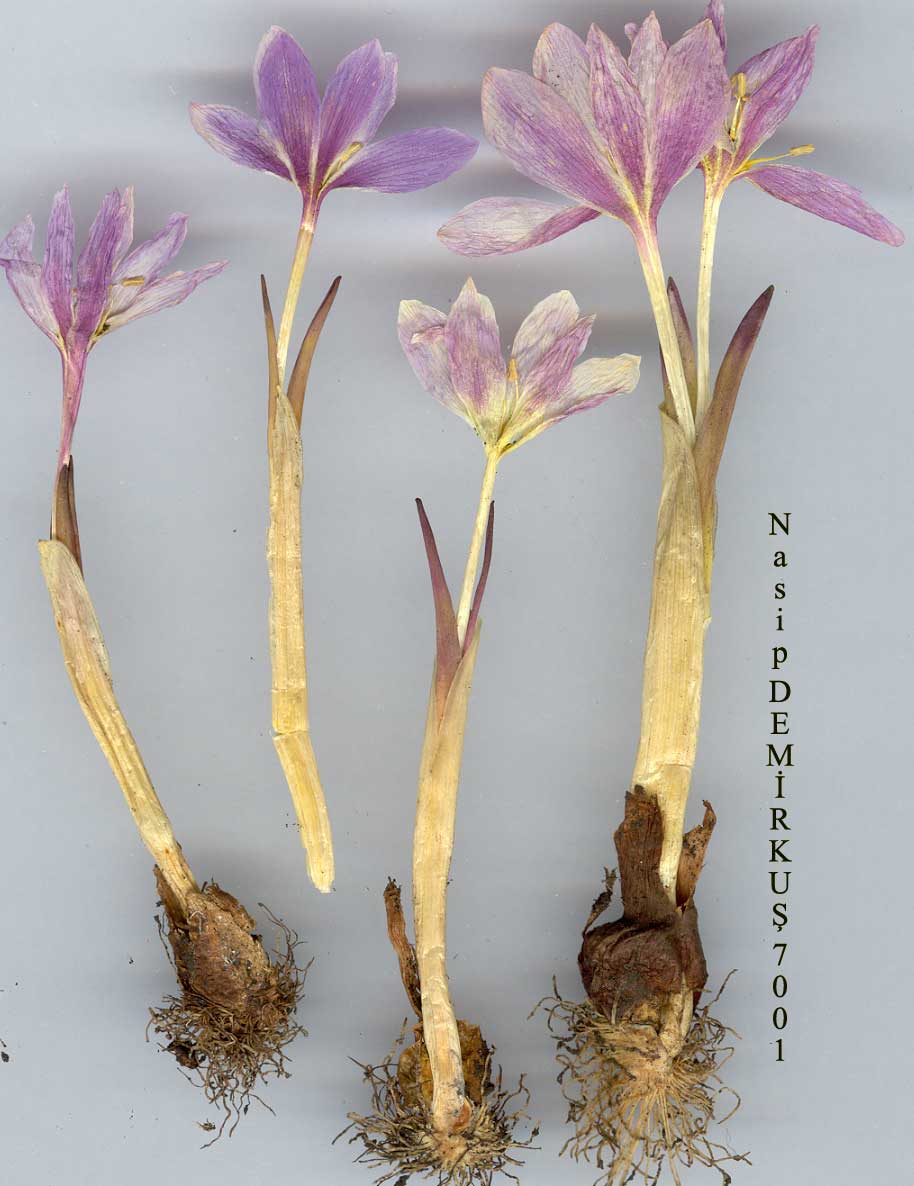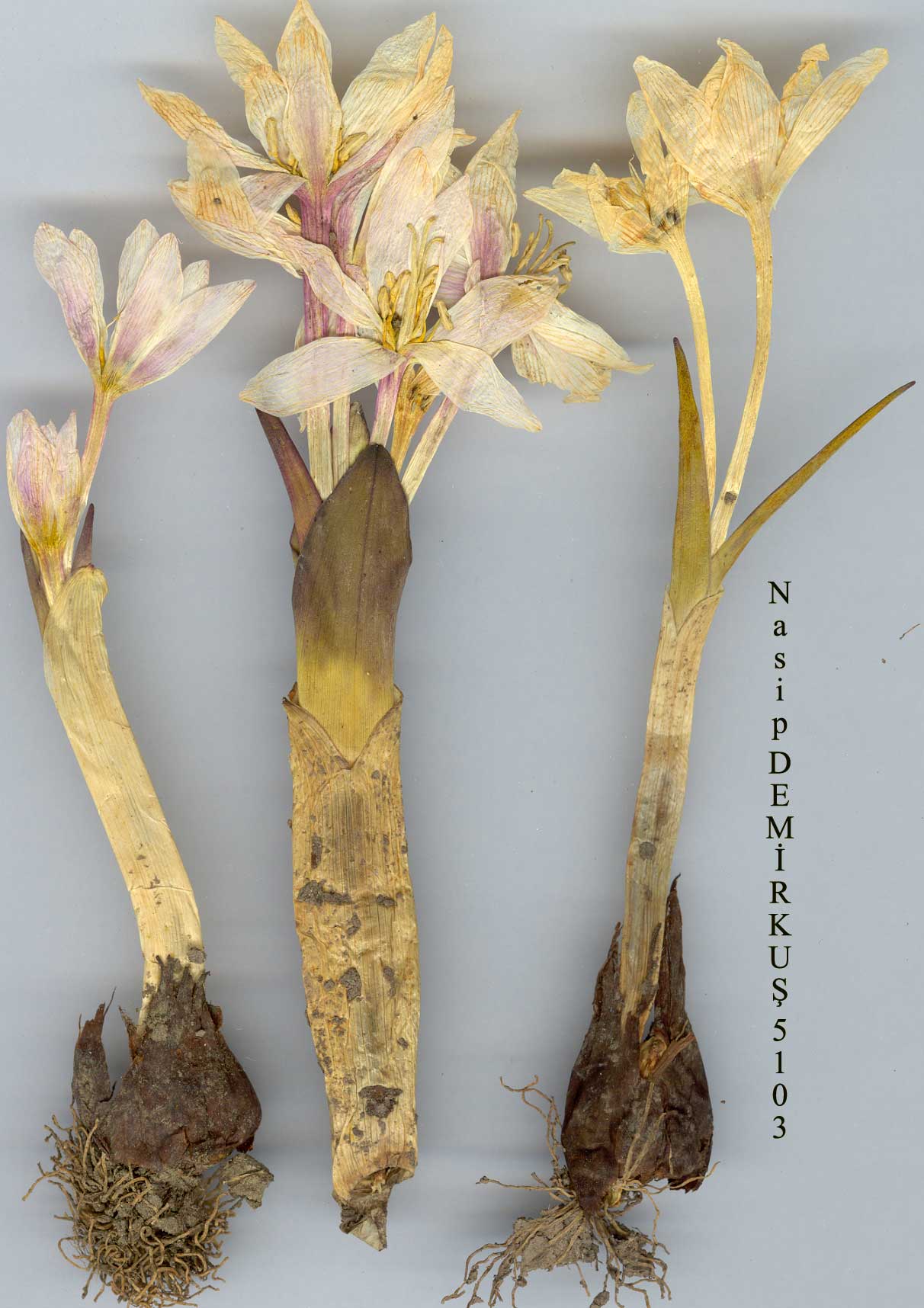| Liliaceae |
|---|
Colchicum L. |
C. szovitsii Fisch. & Mey. in Ind. Sem. Horti Petrop. 1:24 (1835). Syn: C. szowitsii Fisch. & Mey. var. nivale Boiss. &*Huet in Boiss., Diagn. ser. 2(4): 122 (1859)! C. bifolium Freyn & Sint. apud Freyn in Bull. Herb. Boiss. 4:198 (1896)! C. hydrophilum Siehs in Gard. Chron. ser. 3, 29:102, f. 43 (1901)! C. szovitsii Fisch. & Mey. var. bifolium (Freyn & Sint.) Bordz. in Trudy Tiflissk.Bot. Inst. 18:489 (1919)! C. armenum B, Fedtsch. in Not. Syst. (Leningrad) 1:4 (1920)! C, nivale Boiss. & Huet ex Stef., Monogr, Colcbicum 35 (1926) p.p.; C. acutifolium Siehe in sched.! Ic: Bot. Mag. 131: t. 8040 (1905), as C. hydrophilum; Rix & Phillips, Bulb Book 32(a) (I"981). Map 49. Corm 1.5-3(-4) x (l-)2-3 cm, ovoid; outer tunic blackish-brown, inner reddish-brown, papery to subcoriaceous, neck absent or vestigial. Leaves 2-3, synanthous, ligulate or very narrowly linear-lanceolate, suberect, extending 2-6(-12) cm at anthesis, (12-) 16-21 (-25) x(1.2-}2-3.5 cm at maturity, apex acute and often cucullate, glabrous. Flowers (l-)2-5(-7), ovoid-campanulate, sometimes campanulate or narrowly campanulate. Perianth segments deep to pale purplish-pink or white, strongly suffused purplish-pink, obianceolate to very narrowly elliptic, (2.1-)2.7-3.5 cm x 4-10 mm, acute or less frequently obtuse, occasionally with basal auricles. Filaments 7-11 mm, giabrous; anthers purplish-black or greenish-black, 2-4(-5) x i mm; pollen yellow. Styles straight, stigmas punctiform. Capsule ellipsoid to rotund, 3.5(-4 x 1.5-2.2 cm, mid-brown, glabrous, apiculate. Fl, 2-5(-8). Wet meadows, moist alpine turf, steppe, edges of Pinus forest, 200-3250 m. Type: [USSR, Caucasia] in montibus Somchetiae, Szovits (holo. LE! iso. — leaf & fr. — H!). The isotype in H also bears flowers of C. laetum or C. autumnale. N. Turkey, Inner & S. Anatolia. A 1(E)Tekirdağ: Tekirdağ to Inecik, 200 m, A. Baytop (ÎSTE 14883)! A3 Bolu: AbantG., 1100m.Brickell&Mathew 8508! A4 Ankara: Isık Da. pass between Gerede and Kizilcahamam, 1500 m, Watson et al. 510! A6 Sivas: 30 km W. of Suşehri, 1850 m, Kukkonen 5429! A7 Gümüşane: Kaldirim Da., Sint. 1894:5466! Kolath dagh (Kolat Da.), 2440-2475 m, v 1853, Huet (type of C, szovitsii var. nivale)\ A8 Gümüşane: Kop Da. pass, 2400 m, Furse & Synge 829! A9 Kars: Sarikamiş 2000 m, Güneş 1557! B3 Kütahya: Yenice köyü, T. Baytop (ISTE 12486)! B5 Kayseri: Erciyas Da., 2130 m, Balls 240! B6 Maraş: Göksün, 1300 m,Yildiz 2364? B7 Erzincan: Refahiye to Erzincan, 2150 m, Bails 268! B8 Erzurum: 10 km E. of Erzurum, 1890 m, Uotila 15656! B9 Ağri: 15 km W. of Ağri, 1700 m, Kukkonen 5445! C3 İsparta: d. Eğridir, Kapiz, 2 km to Yakaköyil, 1500-1600 m, Peşmen & Güner 2004! C5 içel: nr Giosna (Gözne), Siehe 95 (as C. acuti-folium)\ C6 Maraş: Berit Da., 2500 m, Yildiz 2035! C8 Diyarbakir: nr Diy-arbakir, Sauer 136/57! C10 Hakkari: Mor Da., 3250 m, Watson et al. 2990! Caucasus, Iran. Ir.-Tur. element. Considerable confusion has occurred since Stefanoff used the name C. szovitsii Fisch. & Mey. for plants from N.E. Anatolia, S. & W. Iran and Transcaucasia having 4-5 canaliculate, narrow leaves and starry white or purplish-pink flowers which are here referred to C. falcifolium Stapf. Examination of the holotype of C. szovitsii has shown it to be quite distinct, with 2-3 broad leaves and squat obovoid flowers. ît appears to be inseparable from C. bifolium Freyn & Sint. ex Freyn (1896). The holotype of C. armenum B. Fedtsch. (1920), also at LE, does not significantly differ from specimens of C. szovitsii and the two taxa are here united. The name C, nivale Boiss. & Huet ex Stef. has been applied to diminutive, few-flowered forms of C. szovitsii but variation in the size and number of the flowers and leaves occurs throughout the range of the latter and appears to be more of ecological than taxonomic significance. Siehe 95 from C5 içel, labelled C. acutifolium, closely resembles small, few-flowered plants from A7 Trabzon and A7 Gümüşane previously identified as C. nivale; they appear merely to form part of the natural variation of C, szovitsii. The most vigorous plants are normally found growing in lush meadows, often in very wet conditions, while those of smaller stature occur mainly in well-drained montane steppe. Although the tunics of the shorter plants are usually less well-developed than those from moister habitats, no other significant differential characters have been found to separate them. Extreme states appear distinct but specimens intermediate in size and other characters occur throughout the range. The number of leaves has been considered significant but plants with 2 or 3 leaves may grow together in natural populations. Vigorous plants with 3 leaves from C5 içel, separated as C. hydrophilum Siehe, differ in no other way from 2- or 3-leaved plants from N. Anatolia here referred to C. szovitsii. Material collected by Siehe in Cappadocia (Siehe 101, as C. hygrophilum Siehe) and referred by Hayek in Ann.Nat.Hofmus. Wien 28:183 (1914) to C. brachy-phyllum Boiss. & Hausskn. ex Boiss., is inseparable from robust 2-3-leaved specimens of C. szovitsii. The holotype of C. brachyphyllum (Hausskn. 923, G!) has 4 leaves (the outermost narrowly ovate, the inner lanceolate) and up to 15 flowers. Other specimens apparently referable to C. brachyphyllum have 4-6 lanceolate to narrowly lanceolate leaves but no authentic material of this taxon has been seen from Turkey. |








